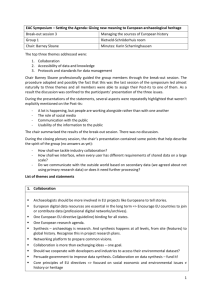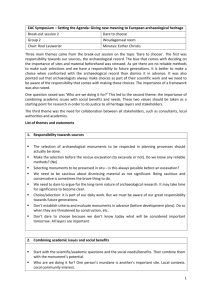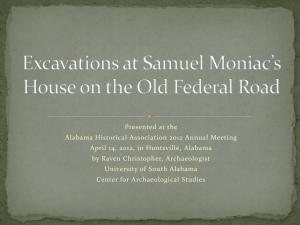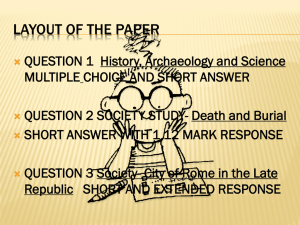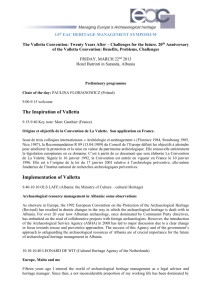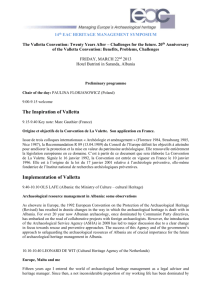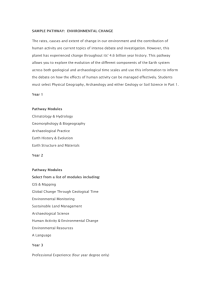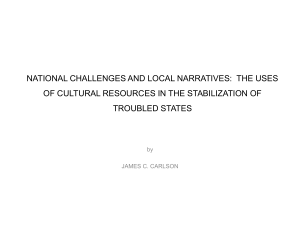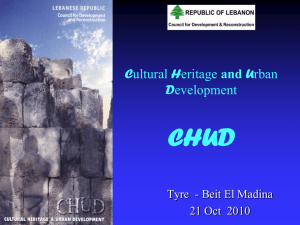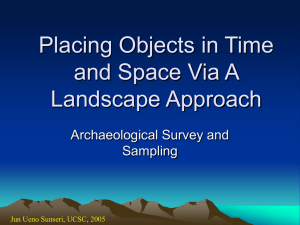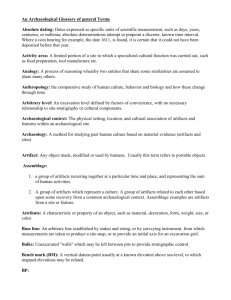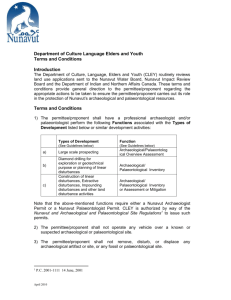EAC Symposium 2014 Setting the agenda: Giving new meaning to
advertisement
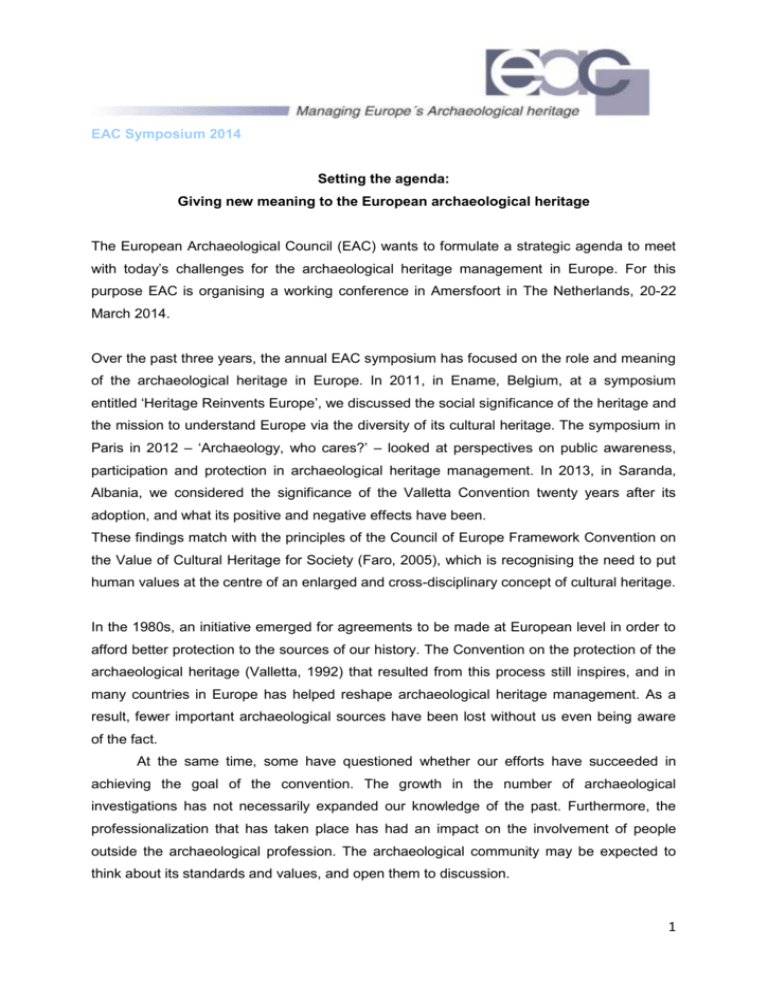
EAC Symposium 2014 Setting the agenda: Giving new meaning to the European archaeological heritage The European Archaeological Council (EAC) wants to formulate a strategic agenda to meet with today’s challenges for the archaeological heritage management in Europe. For this purpose EAC is organising a working conference in Amersfoort in The Netherlands, 20-22 March 2014. Over the past three years, the annual EAC symposium has focused on the role and meaning of the archaeological heritage in Europe. In 2011, in Ename, Belgium, at a symposium entitled ‘Heritage Reinvents Europe’, we discussed the social significance of the heritage and the mission to understand Europe via the diversity of its cultural heritage. The symposium in Paris in 2012 – ‘Archaeology, who cares?’ – looked at perspectives on public awareness, participation and protection in archaeological heritage management. In 2013, in Saranda, Albania, we considered the significance of the Valletta Convention twenty years after its adoption, and what its positive and negative effects have been. These findings match with the principles of the Council of Europe Framework Convention on the Value of Cultural Heritage for Society (Faro, 2005), which is recognising the need to put human values at the centre of an enlarged and cross-disciplinary concept of cultural heritage. In the 1980s, an initiative emerged for agreements to be made at European level in order to afford better protection to the sources of our history. The Convention on the protection of the archaeological heritage (Valletta, 1992) that resulted from this process still inspires, and in many countries in Europe has helped reshape archaeological heritage management. As a result, fewer important archaeological sources have been lost without us even being aware of the fact. At the same time, some have questioned whether our efforts have succeeded in achieving the goal of the convention. The growth in the number of archaeological investigations has not necessarily expanded our knowledge of the past. Furthermore, the professionalization that has taken place has had an impact on the involvement of people outside the archaeological profession. The archaeological community may be expected to think about its standards and values, and open them to discussion. 1 The economic crisis is also an important factor. Public resources for archaeology are in decline and the willingness of the private sector to meet the costs of archaeological research is also coming under increasing pressure. Their archaeological responsibilities are often seen as a burden, rather than a source of pleasure or pride. More than two decades later, we need to launch new initiatives to explore how to treat archaeological values as sources of knowledge about Europe’s past. It seems like a good idea to connect these challenges with the principles of the Council of Europe Framework Convention on the Value of Cultural Heritage for Society (Faro Convention) and thus give new meaning to the archaeological heritage management in Europe. We aim to have an open interactive discussion on the topics which ask more attention on a European scale and which can inspire all participants. The three symposia mentioned above, and the publications that emerged from them, provide fantastic input for the working conference that is to be held in Amersfoort on 20 and 21 March 2014. Topics for a strategic agenda During the working conference EAC wants to formulate a strategic agenda and explore the possibilities of an action programme to make improvements for the archaeological heritage management in Europe. The following topics may be feasible for such an agenda and programme. 1. Managing the sources of European history “enhance the value of the cultural heritage through its identification, study, interpretation, protection, conservation and presentation” (article 5, under b, Faro Convention 2005) 1.1 The harvest of Valletta: Adding to our knowledge of the past The amount of archaeological research being conducted has increased considerably, but there have been few syntheses that bring the resulting information together to form a new bigger picture, and raise new questions about the past. You would expect that this would be the natural stuff of academic endeavour, but the link with universities is weak. Is there enough interaction between academic archaeology and commercial archaeology? Who should be leading? Are academics aware of what developer-led archaeology has yielded? To what extent is the (commercial) research agenda for individual excavations focused on knowledge profits on a higher level? Is the right information being generated? Or 2 are those working in archaeological heritage management simply unable or unwilling to take on this task in an effective manner? How to build a bridge between the major stakeholders to study, share and disseminate information while strengthen each other? Do we want to achieve a synthesis on a European scale and if so, what should be the main themes. What does this mean for national heritage management? 1.2 Exchange of information in a digital area “The Parties undertake to develop the use of digital technology to enhance access to cultural heritage and the benefits which derive from it” (Article 14 Far Convention) All over Europe, information is being generated about our past. Every survey, every excavation, supplies information in the form of digital data, documentation, finds and publications. Access to this information (at European level) could be considerably improved by agreeing on standardisation and by forging connections, connections, connections. Would an archaeological knowledge map of Europe be a feasible idea? What are the benefits and challenges to conquer with an archaeological knowledge map? Can an initiative like ‘Europeana’ inspire the archaeological society? 2 Dare to choose “recognise the public interest associated with elements of the cultural heritage in accordance with their importance to society” (article 5, under a, Faro Convention 2005) 2.1 Quality or quantity? For rigorous selection, one need a good idea of what archaeology one can expect to encounter where, how these values can be effectively traced, and also what has probably already been lost due to things like farming. The better idea we have of things like this, the more rigorously we can select. The maps and methods we need to help us will have to be further developed. Of course, international exchange of ideas on how to tackle this will be vital. In case we want to achieve European exchange what are the main themes which helps to make a statement in this respect? 2.2 What do we want to know? Not all archaeological information is equally important. Selection in and ex situ is a key issue, given the need to ensure that archaeological research has the greatest possible added value, and that archaeological heritage management remains as efficient and cost-effective 3 as possible – not least to keep it socially acceptable. The first question we need to consider is: what questions about the past do we want archaeological research to answer? This is a question that also deserves to be considered at international level, so that national and regional agendas can also address trans-boundary issues. Archaeological methods and techniques can be used in a wide range of situations. We have to ask however whether the use of these methods automatically means that it should be part of archaeology as a science. Is it necessary to renew the definition of archaeology? 3. The spirit of the Faro Convention: embedding archaeology in society Recognising the need to put people and human values at the centre of an enlarged and crossdisciplinary concept of cultural heritage; Emphasising the value and potential of cultural heritage wisely used as a resource for sustainable development and quality of life in a constantly evolving society; (Preamble Faro Convention) Archaeology is not just for archaeologists. Large numbers consumes the results of archaeological research as passive but interested followers by means of visiting museums, reading books, education, visiting excavations, listed sites and archaeological parks, while others have a more a active role in community archaeology, as amateurs, re-enactment or controlling local authorities in the way archaeology is embedded in spatial planning or not. Do we have a role in involving other groups, local communities, the public at large and if so which role? Is the concept of community archaeology worth to promote and how should it be embedded in the often (too?) strictly professional legal framework? Give the future a past by making the past visible and perceivable when implementing spatial plans. What is the most successful approach? Need for international initiative? 4
